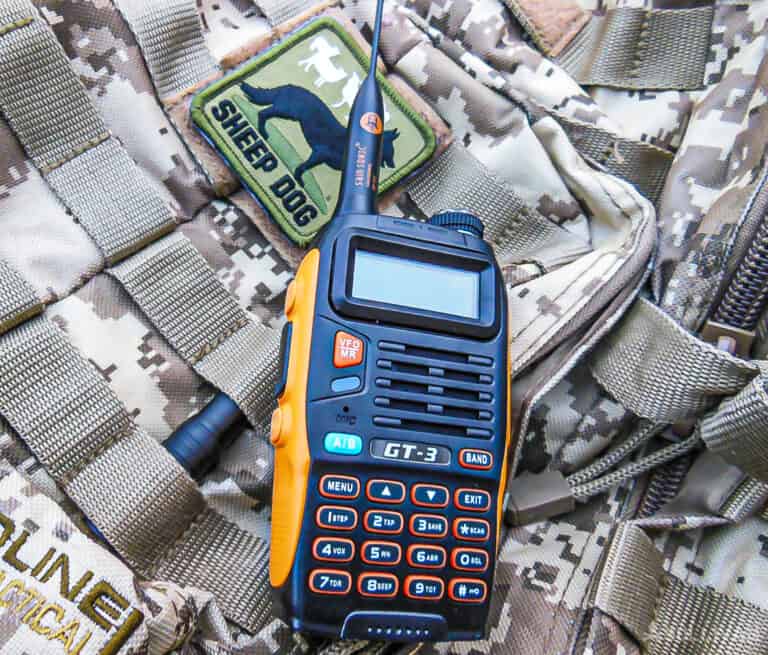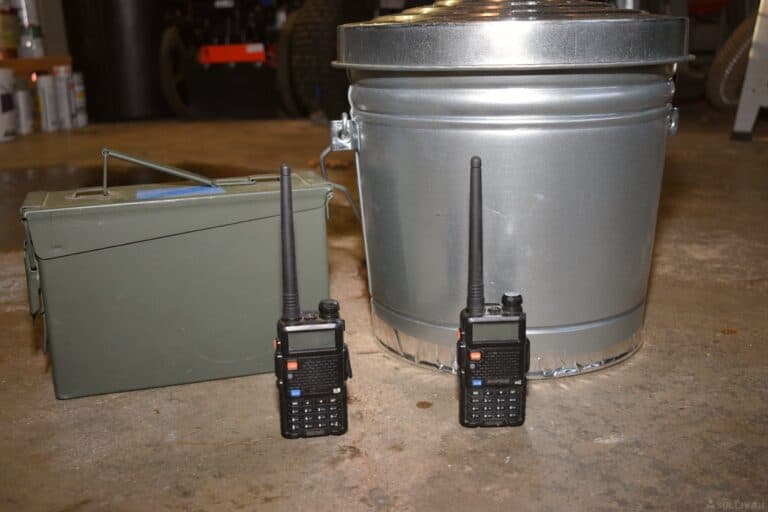If you’ve ever been inside an amateur or ham radio shack, basically an enthusiast setup inside their home, you might have been a little mesmerized: stacks of electronic components, dials, microphones, and all manner of electronic equipment. Chances are if you’ve got the bug, it bit you right then and there…

the Baofeng gt 3 handheld ham radio
So, you’ve done the research and you know that ham is a hobby you want to pursue. How much is a ham radio actually going to cost?
A ham radio setup can cost you as little as $30 or as much as $3,000 or more depending on the kind of radio, the quality, and additional equipment that you need. You can get started with a ham radio today cheaply, though!
Let me tell you, I was probably as surprised as you are now when you saw just how affordable ham radio can actually be. A handheld, completely self-contained radio, even a good one, can cost you way less than $100, and you can get on the airwaves the same day.
Naturally, there are many considerations that you should take into account, and a lot more to know if you want to make a wise choice with your initial investment. Lucky for you, I’m here to help point you in the right direction, so keep reading.
Do I Need to Spend a Lot to Get Into Ham Radio?
No! In fact, it’s a whole lot cheaper than you might have thought before you found this article.
Now, if you want a fully kitted-out ham shack in your home with all the bells and whistles and a tall tower for your antenna, you might be dropping many thousands of dollars, but that’s an extreme case.
If you’re willing to spend anywhere around $200 – $300, you can get a great fixed unit with everything that you need.
But really, all you need is a basic handheld to start playing around with: $100 or even a lot less and you are in business. Baofeng makes some really affordable HAMs that most folks and preppers indeed like to use.
Don’t Forget: You’ll Need Your License!
Now, one small added expense you should keep in mind, and you can’t forget about, is the need for a license. That’s right; legally using a ham radio requires an amateur radio license from the FCC.
You can take a written test or take it online, and assuming you pass and pay the fee, you’ll be ready to go after that, so make sure you prioritize it.
And of course, if you want to study hard for the test so you can be sure that you will pass it, you might need some study guides, online tutoring, or something like that.
Depending on how much info you already have and how hard you want to study, your license and study materials will run you anywhere between $35 and $100.
But once you’ve got it, you’ve got it as long as you don’t let it expire.
Complete, or Build Your Own?
A big consideration for picking out your first ham radio is whether you want a completely self-contained unit like a handheld, or handy talky, or if you want to assemble a complete setup from the various components that are required.
Handhelds are great if you are very impatient or if you want to stay strictly portable and on foot, and they can include everything needed, and that includes a battery, for as little as $30.
If you want to assemble your set à la carte, you’ll need to buy each of the components, or most of them, from the list below, and the prices for those can vary significantly.
Starter ham radio kits that include components pre-chosen for both price and compatibility are a very popular option that will give you some experience in hooking everything up and setting up your unit. Those kits usually run between $200 and $400…
A Ham Radio Always Includes Several Components
Assuming you aren’t buying a handheld which includes all of the following in a small form factor, your Ham Radio setup will need the following. I’ve included a basic price range to help give you an idea of what you can expect to spend based on your budget.
Receiver/Transceiver: this is the heart and soul of the radio, responsible for receiving signals, a receiver, or sending and receiving signals, in the case of a transceiver.
There are many, many brands and options out there, with some of the cheapest running right at $100 and the very best costing around $550 or even a lot more. Better models usually have more power, better controls, and options for functionality.
Power Supply: your transceiver or receiver will need a power supply as most don’t include one. The power supply that you require is completely dependent upon how much power your set needs, so check the specifications before you buy. Expect to spend around $80 or a little less, though some beefy units can run more.
Antenna: arguably the single most important part of a radio set. The antenna is responsible for receiving and sending radio signals, and picking the right one, and one that is of sufficient quality, is essential for good range and clear reception.
Antennas usually run anywhere from $50 to as much as you want to spend depending on quality, type, and material.
Tuner: a tuner is a technically optional but practically essential component of your ham radio set and is used to tune your antenna to the required impedance for optimal function.
These start at around $90, but can cost a lot more. Check in with a seasoned mentor or customer support at a retailer to figure out which kind you need for your set.
Case: depending on the model of receiver or transceiver you buy, and the type of power supply, it might or might not come pre-installed in a case or body.
If you’re really buying a do-it-yourself kit, you’ll need to install these components in a case, which is likely included. Cases can cost as little as $20 bucks all the way up to $100 or even more depending on the type.
Mic: the microphone is the part that you speak into to send your voice out over the airwaves. You can use a separate headset with integrated headphones or a standalone mic.
Handy talkies have this built-in along with auxiliary jacks for connecting other communications equipment. Will run you anywhere from $20 to $300 or more, although the high end of this range is usually only for advanced communications headsets and commercial-grade microphones.
Speaker: a speaker will produce received radio waves as sound, allowing you to hear the people you are talking to.
Many sets have one built-in, but standalone speakers or headphones can once again go anywhere from $20 to hundreds of dollars. You don’t need an especially good speaker for functional sound.
Cables, Connectors, and Misc.: unless your radio is completely self-contained like a handheld portable, you’re going to need a wide variety of cables, connectors, fuses, and more.
A detailed overview of these components is an article by itself, but suffice it to say you’ll need anywhere from $50 to $75 or a little more depending on the specifics of your setup. Do not get bargain basement cables and connectors, though! Bad ones can seriously degrade your experience.
If You Need a Tower, That Can Cost Big Bucks
No, I’m not talking about a tower for a PC. I’m talking about an actual radio tower!
If you live very far away from the people you’re trying to reach or you have a lot of obstructions in your way like tall buildings, hills, mountains, and the like, it is worth raising your antenna up as high as you can to improve reception and transmission.
The best way to do that is with a tower, but that is going to cost some serious cash. The tower itself will set you back at least a couple of thousand dollars, and depending on the height you need it might go up to $10,000.
Likewise, in many jurisdictions, permitting to install such a tower on your property can be highly restrictive and expensive, further increasing costs. You must check before you build, though!
If a tower is out of the question, consider having your antenna installed near the top of a tall tree – if it can be done so safely or installed on a mast that is placed on your roof.

Baofeng radios are inexpensive, small, and capable of communicating over miles.
Budget-Friendly Radio Rig
If you want to get started with ham radio right now, and I mean right this very second, look no further than the Baofeng UV-5R. I know some seasoned ham ops are probably rolling their eyes, but these things are a great entry point into the skill set, and you can do a lot with them.
This portable handheld has everything you need to receive and transmit on VHF and UHF frequencies, meaning it’s a perfect fit for someone starting out with their technician license.
A Nice Mid-Priced Setup
A high-quality handheld option is a significant step up from the Baofeng. The Yaesu FT-60R is durable, has great battery life, and excellent sensitivity compared to cheaper models.
This works wonderfully for a close-to-home set, and it easily slips into a pocket or pouch when you need to head out the door. Expect to spend anywhere from $150 to $200, maybe a bit more depending on the retailer.
All the Bells and Whistles
If cost is no object or you want to be future-proofed for further expansion, ICOM’s IC-7300 is loaded to the gills with top-of-the-line features: real-time spectrum scope, a super user-friendly interface, and stupendous, best-in-class sound quality and clarity.
It even has a touch screen and an automatic tuner built-in. It is uniformly excellent in every way, but you’re going to pay for it: sells for about $1,300.
Don’t Be Afraid to Jump in and Upgrade as You Go
Now, if you looked at my recommendations above and immediately set off on an online shopping spree, you probably started feeling pretty deflated. There are so, so many choices out there it’s easy to get overwhelmed and start suffering from analysis paralysis. Don’t do that!
Either buy a handheld like I said above or a complete kit that is ready to set up and go, and stick to your budget. Then get on the air and start having fun. It’s the very best way to learn, and you’ll find that you can always expand your setup as funds allow.
The post How Much Does a Ham Radio Actually Cost? appeared first on Survival Sullivan.
https://www.survivalsullivan.com/ham-radio-pricings/
 CampingSurvivalistHuntingFishingExploringHikingPrivacy PolicyTerms And Conditions
CampingSurvivalistHuntingFishingExploringHikingPrivacy PolicyTerms And Conditions
